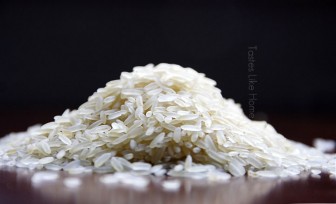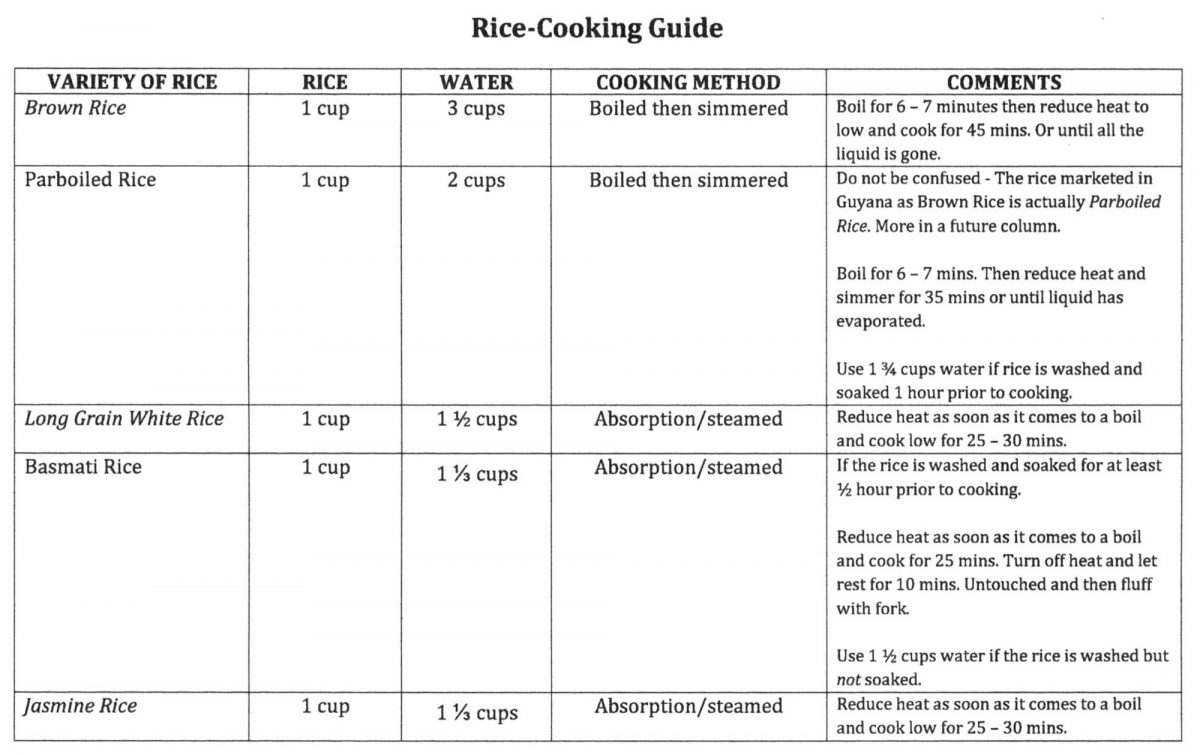Hi Everyone,
All rice is not created equal. Therefore, all rice is not cooked with the same water to rice ratio or using the same cooking methods.
Cooking perfect rice is elusive for many people. For clarification, the use of the word ‘perfect’ in this context refers to the perfection desired by individual households and societies. In other words, some people prefer rice cooked firm while others desire that their rice be cooked soft. It is the same thing with pasta. Some prefer the pasta al dente as most Italians cook it and others prefer their pasta to be cooked all they way through. There is no right or wrong way. The right way is the way you like it. The wrong way is when it is not cooked to your satisfaction.
 There are basically three ways in which we cook rice in the Caribbean – boiled (and drained), boiled and then simmered or cooked using the absorption method, sometimes referred to as steaming.
There are basically three ways in which we cook rice in the Caribbean – boiled (and drained), boiled and then simmered or cooked using the absorption method, sometimes referred to as steaming.
Methods
Boiled and drained – the water is brought to a boil first and then the rice is added to it. Rice is cooked until it reaches the desired degree of doneness and then it is drained.
Boiled and simmered – rice and water are brought to a boil together for a period of time and then the heat is reduced so that all the liquid is absorbed.
Absorption/steamed – rice and water are brought to a boil and as soon as it comes to a boil, the heat is reduced to low and the rice cooks until all the liquid is gone.
Adding salt
Some people add salt to their rice when cooking it while others don’t. Personally, I add a little salt, not enough to taste and affect the overall salt equation of what I am going to serve the rice with, but just enough to take off dullness I find rice can have if it is not cooked with a sprinkle of salt.
When adding salt to the rice, always take into consideration how you plan to serve the rice. For example, if you are planning to serve it with a stew, curry or sautéed vegetables, then you want to add just a little salt so that when the rice is mixed with the curry, stew or vegetables each mouthful offers a balance of taste.

On the other hand, if you are cooking the rice to make fried rice, then I’d suggest that you add salt to taste, as that is the time that the rice really gets properly seasoned. The other ingredients when added are more for flavour notes – ginger, garlic, hot peppers, five spice powder.
Of course it goes without saying that if you are making a one-pot rice dish such as Cook-Up Rice, Pelau or Spanish Rice, that salt will be added to taste for the entire dish.
Washing rice
I often get asked this question – wash the rice or don’t wash the rice. The washing of the rice is a cultural thing and it is also something that is grown out of a need for cleanliness. Depending on your location, some people purchase rice that is already pre-picked, sorted and packaged and it instructs that it can go from the packet to the pot.
For a majority of people the world over, where rice is grown and eaten widely, rice is not only sold pre-packed but also loose. Just take a look around the market and you will see large crocus bags of rice. It is highly recommended that if you buy rice this way that you wash the rice before cooking it. In some cases, you will have to “pick the rice” also. By “pick the rice” I mean that you will remove any unwanted obstacles such as paddy, dark brown grains of rice, bits of pebbles, lint from the crocus bag etc. The other thing is that people would have been running their fingers through the loose
rice to check for its quality etc. Washing loose-bought rice then should be a must.
Although the packaged rice I get suggests that it can go from packet to pot, I still wash my rice and that is partly cultural because that is how I grew up seeing rice being prepared for cooking all around me and even in Barbados where I live. On several occasions, I did the straight to pot cooking of the rice but I found that it made my cooking liquid a little too murky for my liking and it added a particular flavour to the rice that I did not like.
The other reason that I insist on washing my packaged rice is that I know that that rice was lying somewhere in a factory also and that it encountered various environments so I prefer to wash my rice before using it.
Boiling rice
 Here’s the best way to boil rice and then drain it. Bring a large pot of water to boil. Now you want to ensure that the pot has an adequate amount of water so that you do not, I repeat, you do not need to add water while the rice is cooking. Too often, people do not add enough water in the first place, the rice boils for several minutes, the liquid evaporates and the rice dries down and more water needs to be added, and guess what, cold tap water in dumped onto the hot boiling rice and liquid, this cools and slows down the cooking process. Because the cooking process is slowed, more liquid gets absorbed into the rice and the entire pot takes a long time to come back to a boil. By the time the rice is finally done cooking, it is too soft. So, start off by ensuring that the amount of water you have put in the pot to boil is enough to cook the rice to your desired consistency. If you must add extra water, then please add boiling water.
Here’s the best way to boil rice and then drain it. Bring a large pot of water to boil. Now you want to ensure that the pot has an adequate amount of water so that you do not, I repeat, you do not need to add water while the rice is cooking. Too often, people do not add enough water in the first place, the rice boils for several minutes, the liquid evaporates and the rice dries down and more water needs to be added, and guess what, cold tap water in dumped onto the hot boiling rice and liquid, this cools and slows down the cooking process. Because the cooking process is slowed, more liquid gets absorbed into the rice and the entire pot takes a long time to come back to a boil. By the time the rice is finally done cooking, it is too soft. So, start off by ensuring that the amount of water you have put in the pot to boil is enough to cook the rice to your desired consistency. If you must add extra water, then please add boiling water.
When it comes to draining or as we say, straining the rice, I do not rinse it with cold water, I know that some people do, but I don’t. I think that because the rice was washed before it was cooked makes it unnecessary to rinse it. However, I can see why people would want to rinse it if they added it directly from the package, to take away some of the extra starch that might cause the cooked rice to stick together.
Absorption/steaming rice
A friend of mine once complained to me in frustration that she does not understand why when she cooks rice, it is never enough for the household even though she carefully measures ½ cup of raw rice per individual. And by right that should be more than enough given that that ½ cup of raw rice would be equivalent to 1 and ½ cups cooked rice.
One day I was over at her place as she was preparing dinner, I saw her measure the rice, wash it and set it cook. When I saw the size of the pot in which she was cooking the rice, I knew immediately why she was not getting the yield she should – the pot was too small for the amount of rice she was cooking.
Let me explain something. When rice is being cooked using the boiling method – the rice has the opportunity to absorb liquid while rapidly moving around in the pot and interacting with the other grains of rice. It has lots of room to grow to its full potential.
When rice is being cooked by the absorption/steam method, it is being cooked in a more controlled and precise environment. There is a particular ratio of liquid to rice and that rice only has that specific amount of liquid to absorb in order for it to swell and cook. The only additional help that rice cooked under these circumstances will get to bloom, will be as a direct result of the size of the pot in which it is cooked. If the space is restricted, confined, then it can only swell and grow so much. The confined space can also impact on the shape and texture of the end product. My friend’s rice always came out somewhat pasted and looked as if she had cooked broken rice.
Therefore, if you are going to cook rice using the absorption/steam method, ensure that the size of your pot is adequate and up to the task. Of course you don’t want to use an oversized pot either; this will cause too much build up of condensation that will add unwanted liquid to the rice.
One way to determine the size of the pot to use is to add the rice with water to the pot and measure to see that it can hold 4 times that amount. I say 4 instead of 3 times that amount because you have to leave room in the pot if not your pot would be brimming and that would not be a good thing.
Check out my water to ratio guide for cooking rice below:
Cynthia










